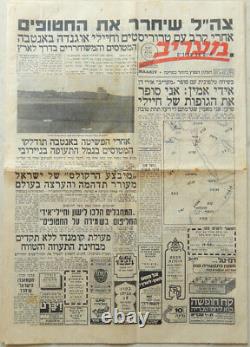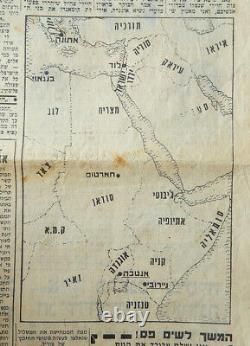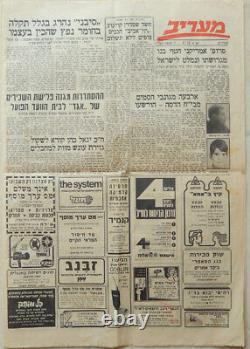
- Home
- Brand
- Model
- 221 Tuna (3)
- E-2c Hawkeye (4)
- Eterna Kontiki (3)
- Eterna Matic (4)
- Eterna Super Kontiki (4)
- F-16 (5)
- F-16c Barak (5)
- F-16i Sufa (8)
- Gamda (3)
- Idf Air Force (3)
- Idf Army Zahal (3)
- Idf Trauma Bandage (5)
- Navigator With Date (15)
- Super Kontiki (3)
- Tank (41)
- Various (12)
- 229 (6)
- 2200 (4)
- 2850 (6)
- 510404 (5)
- Other (3788)
- Religion
- Scale
- Vehicle Make
- Vehicle Type
Operation Entebbe Israel Idf Rescue Air France Flight Newspaper July 4, 1976








OPERATION ENTEBBE ISRAEL RESCUE HIJACKED HOSTAGES NEWSPAPER JULY 4, 1976. For sale, this EXTREMELY RARE MAARIV newspaper that was published at the morning of July 4, 1976 announced for the FIRST time the dramatic news: "ZAHAL RESCUE HIJACKED HOSTAGES". This was the first news that received by Maariv newspaper.. The second title reads THE AIRPLANES AND THE HOSTAGES ON THE WAY TO ISRAEL when the AC130 airplanes were still in the air on the way to Israel.
This is the complete newspaper that contains the full 12 pages with additional articles on Air France flight 139 in inner pages. Please have a look at my other listings. Operation Entebbe or Operation Thunderbolt was a successful counter-terrorist hostage-rescue mission carried out by commandos of the Israel Defense Forces (IDF) at Entebbe Airport in Uganda on 4 July 1976.
[7] A week earlier, on 27 June, an Air France Airbus A300 jet airliner with 248 passengers had been hijacked by two members of the Popular Front for the Liberation of Palestine - External Operations (PFLP-EO) under orders of Wadie Haddad (who had earlier broken away from the PFLP of George Habash), [8] and two members of the German Revolutionary Cells. [9] The flight, which had originated in Tel Aviv with the destination of Paris, was diverted after a stopover in Athens via Benghazi to Entebbe, the main airport of Uganda. The Ugandan government supported the hijackers, and dictator Idi Amin, who had been informed of the hijacking from the beginning, [10] personally welcomed them. [11] After moving all hostages from the aircraft to a disused airport building, the hijackers separated all Israelis and several non-Israeli Jews from the larger group and forced them into a separate room. [12][13][14] Over the following two days, 148 non-Israeli hostages were released and flown out to Paris.
[13][14][15] Ninety-four, mainly Israeli, passengers along with the 12-member Air France crew, remained as hostages and were threatened with death. [16][17] The IDF acted on information provided by the Israeli intelligence agency Mossad. The hijackers threatened to kill the hostages if their prisoner release demands were not met. This threat led to the planning of the rescue operation.
[18] These plans included preparation for armed resistance from the Uganda Army. [19] The operation took place at night. Israeli transport planes carried 100 commandos over 4,000 kilometres (2,500 mi) to Uganda for the rescue operation.
The operation, which took a week of planning, lasted 90 minutes. Of the 106 remaining hostages, 102 were rescued and three were killed.
The other hostage was in a hospital and was later killed. Five Israeli commandos were wounded and one, unit commander Lt.
Netanyahu was the older brother of Benjamin Netanyahu, who would later become Prime Minister of Israel. [20] All the hijackers and forty-five Ugandan soldiers were killed, and eleven[5][6] Soviet-built MiG-17s and MiG-21s of Uganda's air force were destroyed. [4] Kenyan sources supported Israel, and in the aftermath of the operation, Idi Amin issued orders to retaliate and slaughter several hundred Kenyans then present in Uganda. [21] There were 245 Kenyans in Uganda killed and 3,000 fled. [22] Operation Entebbe, which had the military codename Operation Thunderbolt, is sometimes referred to retroactively as Operation Jonathan in memory of the unit's leader, Yonatan Netanyahu.On 27 June 1976, Air France Flight 139, an Airbus A300B4-203, registration F-BVGG (c/n 019), departed from Tel Aviv, Israel, carrying 246 mainly Jewish and Israeli passengers and a crew of 12. [23][24] The plane flew to Athens, Greece, where it picked up an additional 58 passengers, including four hijackers. Just after takeoff, the flight was hijacked by two Palestinians from the Popular Front for the Liberation of Palestine - External Operations (PFLP-EO), and by two Germans, Wilfried Böse and Brigitte Kuhlmann, from the German Revolutionary Cells.
The hijackers diverted the flight to Benghazi, Libya. [26] There it was held on the ground for seven hours for refuelling. During that time the hijackers released British-born Israeli citizen Patricia Martell, who pretended to have a miscarriage.While planning the raid, the Israeli forces had to plan how to refuel the Lockheed C-130 Hercules aircraft they intended to use while en route to Entebbe. The Israelis lacked the logistical capacity to aerially refuel four to six aircraft so far from Israeli airspace.
While several East African nations, including the logistically preferred choice Kenya, were sympathetic, none wished to incur the wrath of Amin or the Palestinians by allowing the Israelis to land their aircraft within their borders. [citation needed] The raid could not proceed without assistance from at least one East African government. The Israeli government secured permission from Kenya for the IDF task force to cross Kenyan airspace and refuel at what is today Jomo Kenyatta International Airport.
Kenyan Minister of Agriculture Bruce MacKenzie persuaded Kenyan President Kenyatta to permit Mossad to collect intelligence prior to the operation, and to allow the Israeli Air Force access to the Nairobi airport. [56] MacKenzie's support for the operation came after Sir Maurice Oldfield, the then head of Britain's MI6 intelligence agency, put his contacts in Mossad in touch with MacKenzie, who had been an MI6 contact for some time. [57] The Jewish owner of the Block hotels chain in Kenya, along with other members of the Jewish and Israeli community in Nairobi, may also have used their political and economic influence to help persuade Kenya's President Jomo Kenyatta to help Israel.
[58] Uganda's Ambassador to Lesotho, Isaac Lumago, [59] overheard some of the details of the operation from Kenya Air Force officers who were discussing the possibility of Israeli compensation for the assistance, and forwarded the information to Ugandan commander Isaac Maliyamungu. Maliyamungu did not alert Amin or take any action on the intelligence, [60] allegedly dismissing the report as "gasiya" (rubbish). [61] According to Amin's son, Jaffar Remo, the Ugandan President still managed to receive Lumago's warning via telephone and, after completing his responsibilities at the OAU meeting, boarded a plane and flew back to Uganda. [59] An ex-agent of Uganda's intelligence service, the State Research Bureau, also claimed that Amin was informed by Lumago of the imminent raid. The agent stated that Amin was terrified of possible reprisals in case his troops actually fought the Israeli military, allegedly resulting in him ordering that the Uganda Army should not open fire on Israeli aircraft during a possible raid.
[62] Two Boeing 707 jets followed the cargo planes. The first Boeing contained medical facilities and landed at Jomo Kenyatta International Airport in Nairobi, Kenya. Ugandan soldiers shot at them in the process. During this brief but intense firefight, Ugandan soldiers fired from the airport control tower. At least five commandos were wounded, and the Israeli unit commander Yonatan Netanyahu was killed.
Israeli commandos fired light machine guns and a rocket-propelled grenade back at the control tower, suppressing the Ugandans' fire. According to one of Idi Amin's sons, the soldier who shot Netanyahu, a cousin of the Amin family, was killed in the return fire.[59] The Israelis finished evacuating the hostages, loaded Netanyahu's body into one of the planes, and left the airport. [74] The entire operation lasted 53 minutes - of which the assault lasted only 30 minutes. All seven hijackers present, and between 33 and 45 Ugandan soldiers, were killed.
[25][need quotation to verify] Eleven[6] Soviet-built MiG-17 and MiG-21 fighter planes of the Uganda Army Air Force were destroyed on the ground at Entebbe Airport. [4][28] Out of the 106 hostages, three were killed, one was left in Uganda (74-year-old Dora Bloch), and approximately 10 were wounded. The 102 rescued hostages were flown to Israel via Nairobi, Kenya, shortly after the raid. This item is in the category "Collectibles\Religion & Spirituality\Judaism\Other Judaism Collectibles". The seller is "levant-fair" and is located in this country: IL.
This item can be shipped worldwide.- Country/Region of Manufacture: Israel
- Religion: Judaism

